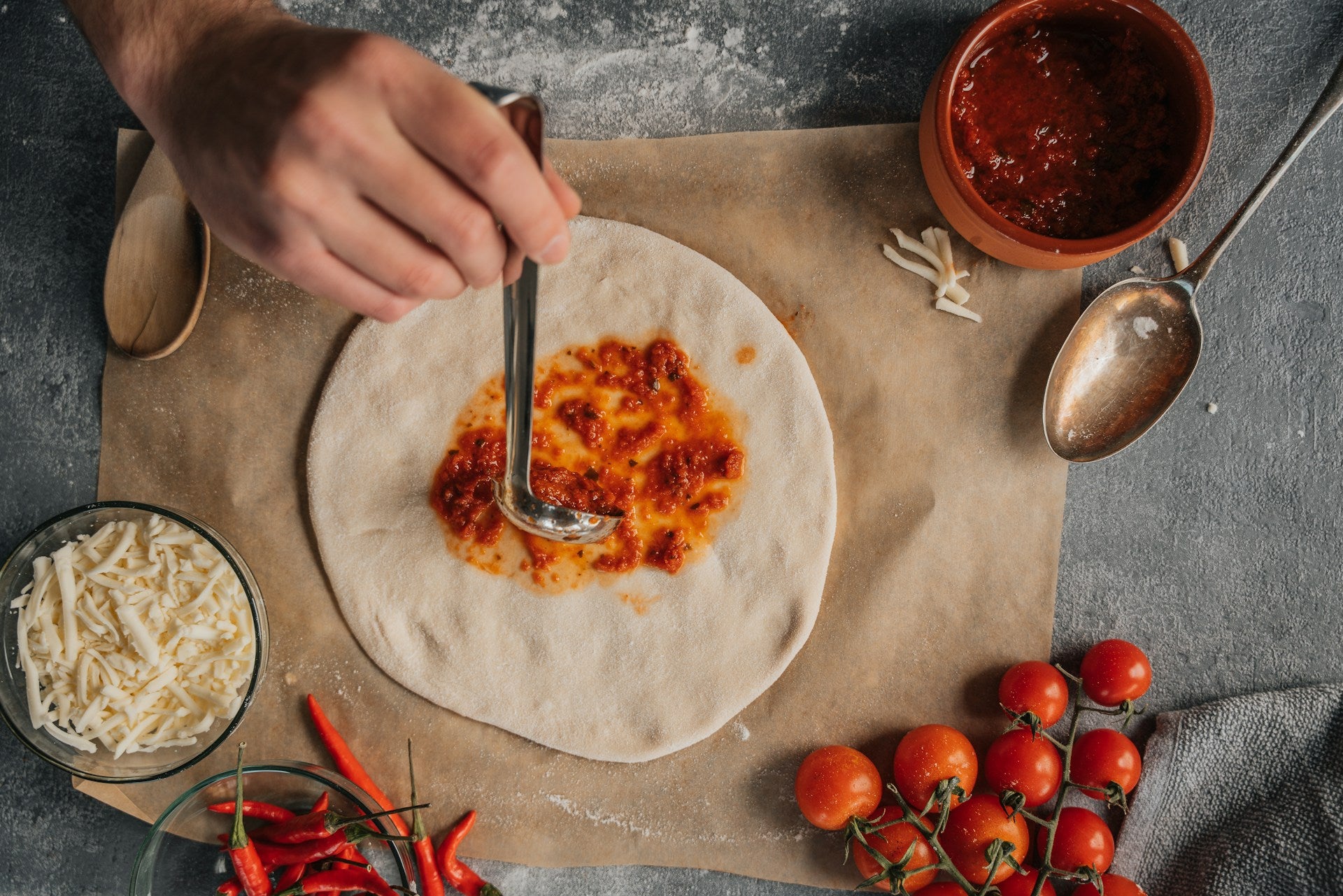The Art of Freezing Pizza Dough
Introduction to Freezing Pizza Dough
Freezing pizza dough is a culinary practice that extends your pizza-making bliss by allowing you to preserve the freshness and flavor of your homemade dough for future use. It is an ideal solution for those who love crafting their own pizza but may not always have the time to start from scratch. By learning the secrets of freezing pizza dough correctly, you can enjoy the convenience of having dough ready whenever the craving strikes.
Benefits of Freezing Pizza Dough
Freezing pizza dough has several advantages for pizza aficionados and busy home cooks alike. Here are some key benefits:
- Time-saving: Preparing dough in advance and freezing it means you can have pizza on the table much faster than starting from scratch each time.
- Waste reduction: Instead of discarding unused dough, you can freeze it for later, reducing food waste.
- Consistency and quality: Freezing dough at its peak ensures consistent quality in your pizza-making endeavors.
- Versatility: Frozen dough isn't just for pizza; it can be repurposed for various recipes, offering flexibility in your meal planning.
By embracing the technique of freezing pizza dough, you can make sure that you're always ready for a pizza party or a quick weeknight dinner. It's crucial to follow proper freezing methods to maintain the dough’s texture and flavor, which we will cover in the following sections of this guide. For inspiration on storage solutions, consider reading about narrow side by side refrigerators or 24 inch undercounter freezers which are perfect for optimizing space while keeping your dough fresh.
Preparing Pizza Dough for Freezing
When you're looking to extend your pizza bliss by unlocking the secrets of freezing pizza dough, the preparation stage is critical. This involves selecting an appropriate dough recipe and properly portioning and shaping the dough before it heads into the freezer.
Choosing the Right Dough Recipe
To ensure your pizza dough freezes well, you'll want to opt for a recipe that's specifically designed for freezing. The best recipes for freezing typically have a slightly higher yeast content, which compensates for any loss of rising power during the thawing process. Additionally, consider the moisture content; a dough that's too wet may not freeze as well as one with balanced hydration.
Here's a simple table to guide you in adjusting your recipe for optimal freezing:
| Ingredient | Standard Quantity | Adjusted for Freezing |
|---|---|---|
| Flour | 100% | - |
| Water | 60% | - |
| Yeast | 1% | 1.5% |
| Salt | 2% | - |
| Sugar | Optional | Optional for browning |
Portioning and Shaping the Dough
Before freezing your pizza dough, divide it into portions that correspond to the size of pizzas you usually enjoy. This not only makes it easier to thaw only what you need but also helps to maintain the quality of the dough by reducing freeze-thaw cycles.
After portioning, shape each piece of dough into a ball. This shape is ideal for freezing as it allows the dough to freeze and thaw uniformly. Once shaped, lightly coat each dough ball with oil to prevent freezer burn and wrap them individually in plastic wrap. For extra protection, place the wrapped dough balls in a heavy-duty freezer bag or an airtight container.
Proper portioning and shaping are crucial steps to ensure that when you're ready to create your pizza, the dough performs as well as fresh dough. For insights on the best storage solutions for your frozen dough, consider reading about maximize space with style best narrow side by side refrigerators or revolutionize your storage choosing the right 24 inch undercounter freezer. These articles may help you find the ideal refrigeration unit for your needs, ensuring your dough remains in perfect condition until you're ready to enjoy it.
Freezing Techniques
Freezing pizza dough is a great way to extend the life of your homemade dough and have it ready whenever you're in the mood for pizza. By employing the right freezing techniques, you can maintain the quality and flavor of your dough for future use.
Proper Wrapping and Storage
To freeze pizza dough effectively, proper wrapping and storage are essential. Begin by dividing the dough into portions you'd typically use for a single pizza. Lightly coat each portion with oil to prevent it from drying out. Then, wrap the dough tightly in plastic wrap. For added protection, place the wrapped dough in a heavy-duty freezer bag or an airtight container, squeezing out as much air as possible to prevent freezer burn.
Label each container or bag with the date, so you can keep track of how long the dough has been stored. Pizza dough can be frozen for up to 3 months while maintaining optimal quality. If you're looking for freezer storage solutions that can accommodate your dough while maximizing space, consider reading about best narrow side-by-side refrigerators or the ideal 24-inch undercounter freezer.
Freezing Fresh vs. Proofed Dough
When it comes to freezing pizza dough, you have the option to freeze it either after its first rise (proofed) or before it has risen (fresh). Freezing fresh dough allows the yeast to remain dormant until you're ready to defrost and use it. On the other hand, freezing proofed dough means the dough has already undergone its initial rise, which can save you time during the thawing process.
| Dough Type | Description | Benefits |
|---|---|---|
| Fresh Dough | Dough that has not risen. | Longer shelf life, flexible usage timing. |
| Proofed Dough | Dough that has completed its initial rise. | Reduced prep time post-thaw. |
Keep in mind that when freezing proofed dough, it may not rise as much after being thawed as fresh dough would. However, both methods can yield delicious results when handled properly. For additional information on how to maximize the shelf life of foods in your refrigerator, explore articles such as extending the life of chicken or how long pizza lasts in the fridge.
By mastering these freezing techniques, you can ensure that you always have high-quality pizza dough at your fingertips, ready to be transformed into a delightful meal.
Thawing and Using Frozen Pizza Dough
Having a stash of frozen pizza dough can turn any night into a pizza party, but knowing the proper methods to bring your dough back to life is key. Here's how you can safely thaw and use your frozen pizza dough for a delicious homemade experience.
Thawing Methods
To ensure the best results, plan ahead and allow your pizza dough to thaw in the refrigerator. This slow process helps maintain the dough's texture and can take anywhere from 10 to 12 hours, so it's best done overnight. If you're pressed for time, a quicker method involves placing the dough in a covered bowl at room temperature, which can take about 2 to 4 hours. Below is a table summarizing the thawing methods and times.
| Thawing Method | Time Required |
|---|---|
| In the refrigerator | 10 - 12 hours |
| At room temperature | 2 - 4 hours |
Make sure your pizza dough is sealed in an airtight container or plastic wrap to prevent it from drying out. You can find more information on proper dough storage in our article about extending your pizza game with maximizing refrigerator pizza dough.
Tips for Using Thawed Dough
Once your dough is thawed, it's almost ready for the oven. However, like a fine wine, it needs a little time to 'breathe.' Let the dough sit at room temperature for 30 minutes to an hour before stretching it. This rest period allows the gluten to relax, making the dough easier to shape and less prone to tearing.
Here are some additional tips to ensure your pizza turns out just as you envision:
- Preheat Your Oven: Ensure your oven is at the highest temperature setting, usually between 450°F to 500°F (232°C to 260°C), for at least 30 minutes before baking.
- Use a Pizza Stone or Baking Sheet: If you have a pizza stone, use it. If not, a baking sheet will work. Preheat it in the oven to give your pizza a crispier crust.
- Stretch, Don't Roll: Use your hands to gently stretch the dough. This technique preserves the air bubbles in the dough, leading to a lighter, airier crust.
- Don't Overload Toppings: A common mistake is piling on too much sauce or cheese, which can result in a soggy crust. Less is more.
- Monitor the Pizza: Keep an eye on your pizza as it bakes. Every oven is different, and cooking times may vary.
For more tips on how to make the perfect homemade pizza, especially if you're using thawed dough, visit our comprehensive guides at Fridge.com.
By following these steps and tips, you'll be ready to craft the perfect pizza with your frozen dough, bringing the pizzeria experience to the comfort of your home.
Enhancing Flavor and Texture
When you're looking to extend your pizza bliss by unlocking the secrets of freezing pizza dough, maintaining the quality and flavor is paramount. Here's how to ensure that your frozen pizza dough remains just as delicious as the day you made it.
Retaining Freshness and Quality
To ensure your pizza dough retains its freshness and quality after freezing, the key is to minimize exposure to air and moisture. Here are some steps you can follow:
- Cool the dough down before freezing to prevent condensation from forming inside the packaging.
- Tightly wrap the dough in plastic wrap, ensuring no parts are exposed.
- Place the wrapped dough in a heavy-duty freezer bag or an airtight container to protect it from freezer burn and odor absorption.
- Label the dough with the freezing date, so you can keep track of its age.
By following these steps, you give your pizza dough the best chance to retain its quality and taste. Also, consider the type of freezer you're using. For instance, a 24 inch undercounter freezer can provide a stable freezing environment, while a 48 side by side refrigerator might offer convenient space for bulk storage.
Flavoring Options for Frozen Dough
Freezing pizza dough doesn't mean you have to compromise on flavor. In fact, there are several ways to infuse flavor into your dough before freezing:
| Ingredient | Quantity | Flavor Profile |
|---|---|---|
| Olive Oil | 1 tablespoon per pound of dough | Rich and smooth |
| Garlic Powder | 1 teaspoon per pound of dough | Savory and aromatic |
| Dried Herbs (Basil, Oregano, Thyme) | 1 teaspoon per pound of dough | Earthy and fragrant |
| Parmesan Cheese | 2 tablespoons per pound of dough | Nutty and cheesy |
Incorporate these ingredients into your dough during the kneading process to ensure even distribution. When you're ready to use the dough, these flavors will have melded beautifully, creating a complex taste profile that enhances your pizza's overall flavor.
For additional tips on working with thawed dough, you might find other articles at Fridge.com helpful. Remember, whether you're storing your dough in a narrow side by side refrigerator or a dedicated 30 refrigerator bottom freezer, the goal is to preserve its freshness for that perfect pizza experience anytime.
Troubleshooting Frozen Dough
Whether you are a seasoned pizza aficionado or a casual home cook, freezing pizza dough can sometimes present challenges. Understanding common issues and knowing how to resolve them will help you maintain the quality of your dough and extend your pizza bliss.
Common Issues with Frozen Dough
Frozen pizza dough might face several issues that can affect its quality and end result. Some of these issues include:
- Dough Becomes Too Dry: Freezing can sometimes draw moisture out of the dough, leading to a drier texture.
- Dough Doesn't Rise After Thawing: If the dough was over-proofed before freezing or has been stored for too long, it might not rise properly.
- Ice Crystals Formation: This can cause freezer burn and negatively impact the dough's texture.
- Uneven Freezing: Parts of the dough may freeze faster than others, especially if not stored correctly, resulting in inconsistent texture.
Solutions and Fixes
To combat the challenges of frozen dough, consider the following solutions:
- To Prevent Dryness:
- Ensure the dough is wrapped tightly with plastic wrap before placing it into a freezer bag.
- Consider lightly coating the dough with oil before freezing to help retain moisture.
- To Encourage Proper Rising:
- Allow enough time for the dough to thaw completely before use.
- Store the dough at a consistent temperature in the freezer to preserve yeast viability.
- To Avoid Ice Crystals:
- Use airtight containers or vacuum-sealed bags to protect against freezer burn.
- Minimize the time dough is exposed to air before it's sealed and frozen.
- For Even Freezing:
- Flatten the dough balls before freezing to help them freeze and thaw more uniformly.
- Freeze the dough in the coldest part of the freezer, typically at the back, away from the door.
Sometimes, despite best efforts, frozen dough might still not perform as expected. In such cases, it might be worth exploring articles such as extend your pizza game maximizing refrigerator pizza dough to find alternative storage methods that better suit your needs. Additionally, familiarizing yourself with the capabilities and features of your freezer can be beneficial. Explore options like revolutionize your storage choosing the right 24 inch undercounter freezer or maximize space with style best narrow side by side refrigerators to ensure you're using the best appliance for your food preservation needs.
By troubleshooting these common issues with diligence and care, you can ensure that your frozen pizza dough remains a convenient and delicious option for your culinary creations.
Beyond Pizza: Creative Uses for Frozen Dough
Frozen pizza dough has many untapped potentials beyond the classic pizza. Its versatility can be a game-changer in the kitchen, allowing you to create an array of delightful dishes.
Versatility of Frozen Pizza Dough
With a batch of frozen pizza dough, you've got the foundation for numerous culinary creations. It can be transformed into various bread-based snacks, desserts, and main courses. Not only does this extend your options for meal planning, but it also ensures that your dough is put to good use, avoiding wastage.
Recipes and Ideas for Frozen Dough
Here are some inventive ways to use your frozen pizza dough:
- Garlic Knots: Thaw the dough and tie it into knots before baking. Brush with garlic butter for a savory treat.
- Calzones: Fill the dough with your favorite ingredients, fold it over, and seal the edges to make a portable meal.
- Pita Pockets: Flatten the dough and bake it to create pockets that can be stuffed with various fillings.
- Doughnuts: Cut the dough into shapes, fry until golden, and coat with sugar or icing.
- Pretzels: Twist the dough into the classic pretzel shape, boil briefly in baking soda water, and bake.
- Focaccia: Flatten the dough onto a pan, add herbs and toppings, and bake for an Italian-style bread.
Each of these ideas offers an opportunity to explore new flavors and textures while utilizing your frozen dough stock. Remember, the key to perfecting these dishes is to ensure proper thawing and handling of the dough. For guidance on thawing and using frozen dough, consider reading other articles at Fridge.com.
Moreover, storing your dough correctly is essential to maintain its quality. Whether you're using a narrow side by side refrigerator or a 24-inch undercounter freezer, proper wrapping and placement in the appliance are crucial. For those who love to entertain or have large families, learning about 33-inch French door fridge options or the luxury of a 48-inch side by side refrigerator could be beneficial.
Frozen pizza dough is more than just a base for your favorite pizza; it's a versatile ingredient that can inspire a variety of dishes. By experimenting with different recipes and techniques, you can maximize the potential of your frozen dough and enjoy a range of delicious meals.
The Art of Freezing Pizza Dough
Introduction to Freezing Pizza Dough
Freezing pizza dough is an excellent technique for extending the life of your homemade dough. Whether you're a seasoned home chef or a beginner, understanding the proper methods of freezing can make your pizza preparation more efficient and still delicious.
Benefits of Freezing Pizza Dough
By freezing your pizza dough, you save time and always have a base ready for your next pizza adventure. It's also an economical choice, reducing waste by preserving the dough for future use. Freezing can maintain the yeast's potency, ensuring that your dough will rise perfectly even after being stored.
Preparing Pizza Dough for Freezing
Choosing the Right Dough Recipe
For optimal results, select a dough recipe with a higher hydration level. Doughs with adequate moisture content tend to freeze and thaw better, retaining their texture and elasticity.
Portioning and Shaping the Dough
Before freezing, divide your dough into individual portions. This step simplifies the process, making it easier to thaw only what you need for each pizza. Shape each portion into a ball, which will help it freeze and thaw evenly.
Freezing Techniques
Proper Wrapping and Storage
Wrap each dough ball tightly with plastic wrap or place it in an airtight container to protect it from freezer burn and odor absorption. Proper wrapping also maintains moisture levels, preserving the quality of your dough.
Freezing Fresh vs. Proofed Dough
Decide whether to freeze your dough before the first rise (fresh) or after proofing. Freezing fresh dough allows the yeast to activate when you're ready to use it, while freezing proofed dough can save you time on the day of baking.
Thawing and Using Frozen Pizza Dough
Thawing Methods
To thaw your dough, transfer it to the refrigerator for a slow, gradual thaw overnight. For a quicker method, you can leave it on the countertop at room temperature, covering it with a damp cloth to prevent drying.
Tips for Using Thawed Dough
Once thawed, allow your dough to reach room temperature before stretching it out. This ensures that the gluten has relaxed, making it easier to shape your pizza without tearing.
Enhancing Flavor and Texture
Retaining Freshness and Quality
Freezing slows down yeast activity but doesn't kill it. Upon thawing, the yeast resumes its work, which can enhance the flavor profile of your dough.
Flavoring Options for Frozen Dough
Consider adding herbs or seasonings to your dough before freezing. This infuses the dough with additional flavors, making for a more aromatic and tasty crust.
Troubleshooting Frozen Dough
Common Issues with Frozen Dough
Issues such as dryness, lack of rise, or a crumbly texture can occur with improperly stored frozen dough.
Solutions and Fixes
Ensure your dough is tightly sealed before freezing and allow it to fully thaw and come to room temperature before use. If the dough seems dry, kneading it with a touch of olive oil can restore its suppleness.
Beyond Pizza: Creative Uses for Frozen Dough
Versatility of Frozen Pizza Dough
Thawed pizza dough can be used for a variety of recipes beyond traditional pizza, including calzones, breadsticks, and even dessert pizzas.
Recipes and Ideas for Frozen Dough
Explore using your frozen pizza dough for creative dishes that can be enjoyed at any time. From savory strombolis to sweet cinnamon rolls, the possibilities are endless.
Freezing pizza dough is a smart and convenient way to ensure you're always prepared for a pizza night. With these tips and techniques, you can maintain the freshness and flavor of your dough, ready to be transformed into delectable creations. Don't forget to check out our articles on maximizing refrigerator pizza dough and the fridge chronicles how long is your pizza good for for more insights on pizza preservation.
Get Your Upgrade or New Addition at Fridge.com
Shop the world's best brands at Fridge.com.
Whether you're searching for your perfect fridge, freezer, wine fridge, beer fridge, ice maker, or kegerator, we have what you need.
We also have tons of awesome articles about kitchen stuff and home news. Enhance your home, garage, backyard, patio, and office with the coolest essentials. With every necessary type of residential refrigerator or freezer in our collection, we've got you covered.
Elevate your game and shop now at Fridge.com!






